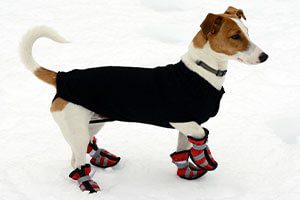5 Ways to Keep Your Dog’s Paws Safe This Winter
If you live in an area that gets cold enough for snow and ice, you may have questioned if it was safe to go for a walk with your dog. In areas where the temperatures drop to 32 degrees Fahrenheit or less, it is important to protect your dog’s paws.
Read our Columbus, OH, animal hospital‘s blog post to find out how you can keep your dog’s paws safe from winter harm.

Winter Weather Dangers
Ice, salt and snow can be damaging to your dog’s paws. Hypothermia and frostbite can be a deadly effect of winter weather dangers. Learn what to look for and how to prevent cold weather harm while still enjoying the outdoors with your furry friend.
Hypothermia
Hypothermia sets in when an animal’s body temperature drops drastically. This is usually caused in one way or another by cold weather. Hypothermia slows the heart rate and breathing which can lead to other health problems as well.
Frostbite can cause hypothermia if left untreated in pets whose paws are not protected. Hypothermia can also cause frostbite. While there are breeds built to handle cold weather conditions, dogs are at risk for hypothermia if exposed to temperatures of 20 degrees Fahrenheit or less. So, keep this in mind when planning for cold weather adventures.
Hypothermia can be divided into three levels; mild, moderate, and severe:
Mild Hypothermia
Causes your dog’s body temperature to drop to 90-99 degrees Fahrenheit
Moderate Hypothermia
Causes your dog’s temperature to drop to 82-89 degrees Fahrenheit
Severe Hypothermia
Causes your dog’s internal temperature to drop below 82 degrees Fahrenheit
Symptoms of hypothermia include:
- Sluggish
- Delayed reactions
- Paleness
- Heart rate increases followed by a slow heartbeat
- Breathing rapidly followed by slow and shallow breathing
- Dilated pupils
- Fainting or loss of consciousness
- Depression
Frostbite
Frostbite is damage caused to a dog’s skin and tissues due to extreme cold. Dogs are susceptible to frostbite in temperatures of 32 degrees Fahrenheit or lower.
When cold temperatures threaten, blood vessels constrict and narrow. They do this to preserve core temperature. Unfortunately, it leaves the toes (or paws) and other outer parts unprotected. Damage occurs in these areas when the tissue freezes.
Your dog’s breed can affect how susceptible they are to frostbite. Cold weather breeds, such as Huskies, Malamutes, Great Pyrenees, and other double coated breeds are less prone to getting frostbite. However, they can still get it as the bottoms of their paws have less fur than their bodies, so it is important to be aware and regularly check their paws
The amount of time your dog spends out in the cold while unprotected can cause frostbite. If left untreated, this can turn into hypothermia.
Small dogs, short haired dogs, puppies, and senior dogs are more vulnerable than large adult dogs. Dogs with diabetes, heart disease, and other conditions that reduce blood flow are also more susceptible to frostbite.
Symptoms of frostbite include:
- Pain when the body part is touched
- Swelling of the affected areas
- Blisters or skin ulcers
- Areas of blackened or dead skin
- Discoloration of the affected areas
- Coldness or brittleness of affected areas

Ways To Keep Your Dog’s Paws Safe
There are a few things you can do to protect your dog’s paws in the wintertime. Preventing hypothermia and frostbite are the most important things, when you live in an area with cold weather.
Booties
The best way to protect your dog’s paws is to cover them. You can purchase booties for your dog. They come in many sizes and colors. If your dog doesn’t like them, you’ll want to use as many of the other preventive measures below as possible.
What to look for when buying boots for your dog:
- Textured sole to give your pup a good grip
- A flexible sole
- Adjustable straps
- Waterproof or water-resistant
- Follow the recommended sizing guidelines
Your dog may not like the booties at first, but with patience, positive reinforcement and gradually increasing the time your dog wears the boots will help create more positive feelings about them. Dog or baby socks may help make the booties more comfortable.
Best Booties for Dogs:
- Ultra Paws Durable Dog Boots
- Kurgo Blaze Cross Dog Shoes
- Ruffwear Grip Trex Outdoor Dog Boots
- Qumy Dog Boots
- DOG Australia Warm Winter Dog Boots
Vaseline or Paw Balm
If your dog simply refuses to wear booties, try putting paw balm or Vaseline (petroleum jelly) on their paws before taking them for a walk. Both Paw Balm and Vaseline will protect your dog’s paws for short walks. The barrier they create protects your dog’s paws from snow and ice.
Apply Paw Balm before the walk to create that protective barrier. After your walk, dry your dog’s paws well and apply more paw balm.
Veterinarian Recommended Paw Balms:
- Honest Paws Dog Paw Balm
- Pet MD Dog Paw Balm
- Vets Preferred Paw Balm
- Petsmont Organic Paw Balm
- Bodhi Dog Certified Organic Paw Balm
- Pet Head Oatmeal Natural Paw Butter
- Burt’s Bees All Natural Paw and Nose Lotion
- Musher’s Secret (highly recommended through vet field and sports dog owners)
Handy Towel
A towel is another important tool. Keep a dry towel near the door to wipe your dog’s paws when you come in from a walk. Make sure to wipe between the toes to get all water, ice, and snow off.
It is also important to wipe your dog’s paws to clean off salt and chemicals from sidewalks. You can also dip your dog’s paws in lukewarm water to rinse them before drying them with the towel. Use a clean towel each time to prevent adding dirt from a dirty towel.
Short Walks
Your dog can get hypothermia or frostbite in less than 20 minutes. In extremely low temperatures, frostbite and hypothermia happen faster. Therefore, it is important to keep walks short.
You may need to take your dog out for more walks and play with them indoors to use up energy. Walks and time outside should be limited. Keeping walks under 10 minutes along with using paw balm will help protect your dog’s paws.
Shovel Snow
If you have a fenced yard, shoveling snow will help protect your dog’s paws. Snow shoveling may not be fun, but the less contact your pup has with the snow the better for their paws.
Pile up the snow in a corner of the yard. You can also shovel paths to create a maze if the snow is deep enough. If you can’t clear all the snow, use booties or paw balm whenever your dog goes outside.
If You Have Concerns About Your Dog’s Paws, Reach Out to Our Columbus, OH, Animal Hospital
The colder the weather, the more important it is that you protect your dog’s paws in as many ways as possible. With these five ways to protect your dog’s paws you can be sure that your pet has the best chance of avoiding hypothermia and frostbite.
If you believe your dog may have problems with their paws, please reach out to our Columbus, OH, veterinarians by giving our animal hospital a call at (614) 451-1204.
Recent Posts
About North Kenny Veterinary Hospital
North Kenny Veterinary Hospital has been serving Columbus, OH pet families with exceptional veterinary medicine since the 1950s. We put a strong emphasis on preventive medicine as well as low-stress handling to help pets have a more pleasant veterinary experience. We use Fear Free techniques for every cat and dog to help reduce their anxiety and calm their nerves.
